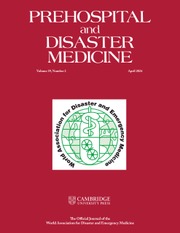No CrossRef data available.
Article contents
Machine Learning Prediction for Supplemental Oxygen Requirement in Patients with COVID-19
Published online by Cambridge University Press: 13 July 2023
Abstract
The coronavirus disease (COVID-19) poses an urgent threat to global public health and is characterized by rapid disease progression even in mild cases. In this study, we investigated whether machine learning can be used to predict which patients will have a deteriorated condition and require oxygenation in asymptomatic or mild cases of COVID-19.
This single-center, retrospective, observational study included COVID-19 patients admitted to the hospital from February 1, 2020, to May 31, 2020, and who were either asymptomatic or presented with mild symptoms and did not require oxygen support on admission. Data on patient characteristics and vital signs were collected upon admission. We used seven machine learning algorithms, assessed their capability to predict exacerbation, and analyzed important influencing features using the best algorithm.
In total, 210 patients were included in the study. Among them, 43 (19%) required oxygen therapy. Of all the models, the logistic regression model had the highest accuracy and precision. Logistic regression analysis showed that the model had an accuracy of 0.900, precision of 0.893, and recall of 0.605. The most important parameter for predictive capability was SpO2, followed by age, respiratory rate, and systolic blood pressure.
In this study, we developed a machine learning model that can be used as a triage tool by clinicians to detect high-risk patients and disease progression earlier. Prospective validation studies are needed to verify the application of the tool in clinical practice.
- Type
- Lightning and Oral Presentations
- Information
- Prehospital and Disaster Medicine , Volume 38 , Supplement S1: 22nd Congress on Disaster and Emergency Medicine , May 2023 , pp. s88
- Copyright
- © The Author(s), 2023. Published by Cambridge University Press on behalf of World Association for Disaster and Emergency Medicine





